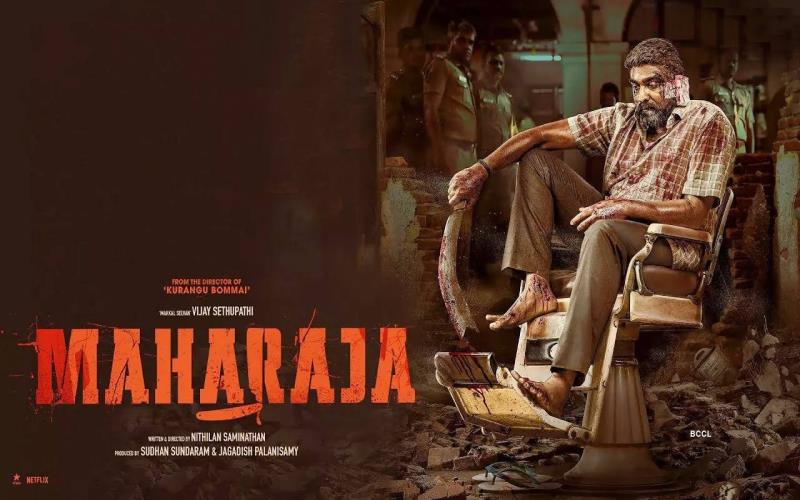Maharaja Movie Review: A Regal Drama of Power, Legacy, and Betrayal
Introduction to Maharaja
Maharaja is an engaging drama that intricately weaves family dynamics, power struggles, and personal transformation into a captivating narrative. Directed with finesse, the film offers a thought-provoking exploration of ambition and redemption. Maharaja draws audiences in with a compelling storyline, relatable characters, and emotional depth, making it a standout film that resonates with viewers of all ages. With a mix of intense drama, heartfelt emotions, and striking visuals, the film showcases the complex journey of individuals grappling with responsibility, loss, and personal growth. This detailed review delves into the plot, performances, music, and overall impact of the film, highlighting what makes Maharaja a cinematic triumph.
Plot and Storyline of Maharaja
The plot of Maharaja revolves around a young man who unexpectedly finds himself inheriting power and responsibility following a personal tragedy. The story explores his transformation from an unwilling heir into a leader who must reconcile with his past and make peace with his future. Set against the backdrop of a powerful family dynasty, the protagonist navigates internal conflicts and external threats to protect what matters most.
The narrative is layered with themes of family loyalty, betrayal, and self-acceptance, offering a rich storyline that keeps audiences engaged from start to finish. The film deftly combines drama with moments of levity, adding emotional depth to the protagonist’s journey. With every twist and turn, the film builds toward a powerful climax where choices must be made, and consequences must be faced, leaving viewers with a thought-provoking message about leadership and sacrifice.
Performances and Character Development
The performances in Maharaja are nothing short of spectacular. The lead actor delivers a standout performance, portraying the evolution of his character from a reluctant individual to an empowered leader with precision. His portrayal captures the inner conflict of someone grappling with the weight of responsibility, making the character relatable and deeply human.
The supporting cast also plays a significant role in elevating the film. Each character is given room to develop, contributing meaningfully to the narrative. The protagonist’s interactions with his family members, especially his mentor, love interest, and rivals, provide emotionally charged moments that enhance the storytelling. The chemistry between the cast members is palpable, making their relationships believable and authentic.
Even minor characters add depth to the plot, bringing nuance to the overarching theme of personal transformation. The performances are subtle and emotionally resonant, ensuring that every scene leaves a lasting impact on the audience.
Direction and Screenplay
The direction of Maharaja stands out for its attention to detail and nuanced storytelling. The director skillfully balances drama, emotion, and action, creating a narrative that flows seamlessly. The screenplay is well-structured, with dialogues that feel natural and meaningful. Every scene serves a purpose, whether in advancing the plot or offering insights into the characters’ inner struggles.
The narrative pace is perfectly calibrated, allowing audiences to connect with the characters and their journeys. Moments of tension and resolution are well-timed, ensuring that viewers remain engaged throughout. The screenplay also avoids unnecessary melodrama, focusing instead on emotional authenticity and meaningful conversations that drive the story forward.
Cinematography and Visual Appeal
The cinematography of Maharaja plays a crucial role in enhancing the film’s impact. The visuals capture the grandeur of the setting, with sweeping landscapes and intricately designed interiors that reflect the opulence of the protagonist’s world. The contrast between light and shadow is used effectively to convey the emotional tone of different scenes, adding depth to the storytelling.
The camera work is fluid and immersive, ensuring that action sequences are visually dynamic without overwhelming the narrative. Close-up shots are used to great effect, highlighting the emotions of the characters during intimate moments. The cinematography also captures the cultural richness and heritage that form the backdrop of the story, adding layers to the film’s visual narrative.
Music and Background Score
The music of Maharaja complements the narrative beautifully, enhancing the emotional depth of the story. The background score subtly underscores key moments, adding gravitas to the scenes without overshadowing the performances. The soundtrack features a mix of soulful melodies and energetic tracks, reflecting the protagonist’s emotional journey.
Each song is thoughtfully placed, reinforcing the themes of love, loss, and redemption. The music transitions smoothly between scenes, ensuring that the narrative remains cohesive and engaging. The sound design is impeccable, with every element contributing to the immersive experience of the film.
Themes and Emotional Resonance
At its core, Maharaja is a film about identity, responsibility, and personal transformation. The narrative explores how individuals must confront their pasts to embrace their futures, offering a profound message about self-discovery and acceptance. The film also delves into the complexities of familial relationships, highlighting how love, loyalty, and rivalry shape personal growth.
Through the protagonist’s journey, the movie emphasizes the importance of making difficult choices and accepting the consequences. The film’s themes resonate with viewers, encouraging reflection on the role of leadership and the sacrifices it demands. Maharaja is not just a story about power but about the emotional strength required to wield it wisely.
Audience Reception and Box Office Performance
Upon its release, Maharaja received widespread acclaim for its compelling narrative, exceptional performances, and stunning visuals. Critics praised the film for its nuanced storytelling and emotional depth, while audiences appreciated the relatability of the characters and the richness of the plot.
The movie performed well at the box office, becoming a favorite among film enthusiasts. Word-of-mouth recommendations and positive reviews contributed to its success, with many viewers applauding the film’s ability to combine drama and emotion seamlessly. Maharaja also sparked discussions on social media, further boosting its popularity and cementing its place as one of the year’s most memorable films.
Conclusion
In conclusion, Maharaja is a cinematic gem that offers a thought-provoking exploration of personal growth, responsibility, and leadership. With its engaging narrative, powerful performances, and stunning visuals, the film leaves a lasting impact on its audience. Maharaja masterfully balances drama and emotion, ensuring that viewers are not only entertained but also inspired by the protagonist’s journey.
If you are looking for a film that offers more than just entertainment and explores the complexities of family, ambition, and self-discovery, Maharaja is a must-watch. Its themes of redemption and personal transformation will resonate with audiences, making it a film worth revisiting.


